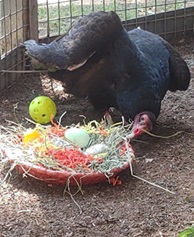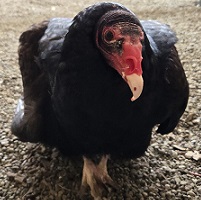Western Turkey Vulture
Cathartes aura aura
- Habitat: open country and woodlands
- Range: Southern Canada to South America
- Natural Diet: carrion occasionally small mammals, birds, and reptiles
- Status In The Wild: Common
All about the Turkey Vulture
Turkey Vultures are closely related to hawks, eagles, falcons, and kites. They are scavengers with well-developed talons and hooked bills with which they tear up their meat to eat more efficiently. Their plumage is mostly black with black, grey, and cream-colored undersides and dark brown wings. Their heads and legs are featherless and pink while their scaly feet are light brown. Their short, curved beaks are creamish-white.
Turkey vultures are monomorphous with both males and females similar in color, shape, and form. They are active during the day (diurnal) and they have highly developed senses of sight and smell that help them look for carrion. They are large birds of two and a half and three feet in body length and with a wingspan of about seven feet. They are about five pounds in weight.
Diet/ Habitat/ Range
Turkey Vultures have a very wide
distributional range spanning North America (Canada, USA, and
Mexico), Central America (Panama, Costa Rica, Nicaragua, Honduras,
El Salvador, Guatemala, and Belize), South America (Argentina,
Bolivia, Brazil, Chile, Colombia, Costa Rica, Ecuador, El Salvador,
Guatemala, Honduras, Mexico, Nicaragua, Panama, Paraguay, Peru, the
Dominican Republic and Uruguay), and the Caribbean Islands. They are
habitat generalists living in varied ecosystems including deserts,
rocky regions, shrublands, and forested habitats.
Like other vultures, Turkey Vultures are scavengers and feed mainly
on the carrion of mammals, birds, and reptiles.
Behavior
Turkey Vultures that live in the northern portion of their distributional range migrate south during the winter months while those living in the southern portion either migrate short distances or do not migrate.
These vultures compete inter-specifically and intra-specifically with other scavenging animals for food during which they grunt, hiss, or bark at their competitors and predators. They do not defend territories but do maintain home ranges. The sizes of their home ranges vary depending on the availability of food (carrion). Turkey Vultures, like other vultures, are known to roost in large community groups.
Reproduction
Turkey Vultures select a single partner they pair with for the breeding season and sometimes for the entire year. They breed once yearly. Breeding is initiated through a sequence of courtship displays that includes diving, soaring, and flapping. Several vultures have also been recorded hopping on the ground in a circular formation with their wings partially spread out. While they breed during the spring and summer months, their breeding season varies across their distributional range, depending on the location of their habitat. They build their nests on cliffs and rocky outcrops, tree hollows, logs, and on man-made structures in urban environments using bark, twigs, sticks, grasses, and leaves.
Females can lay between one to three eggs in a clutch. The eggs are incubated for a month before they hatch. Both male and female Turkey vultures incubate the eggs and feed their chicks (biparental care). The chicks fledge when they are about two to three months old and are able to fly.
Conservation/Status
Since the free-ranging populations of Turkey Vultures have been estimated to be currently stable, they have been categorized as Least Concern by the International Union for World Conservation. Turkey Vultures are also protected by the U.S. Migratory Bird Act.



